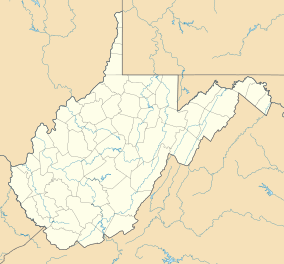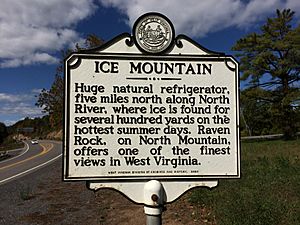Ice Mountain facts for kids
Quick facts for kids Ice Mountain Preserve |
|
|---|---|
|
IUCN Category V (Protected Landscape/Seascape)
|
|
| Location | Hampshire, West Virginia, United States |
| Area | 149 acres (60 ha) |
| Elevation | 1,509 ft (460 m) |
| Website | Ice Mountain Preserve |
Ice Mountain is a special place in Hampshire County, West Virginia, United States. It's a mountain ridge with a unique feature: an "algific talus slope." This means it has a pile of rocks at its base that acts like a natural refrigerator!
This amazing spot is part of a 149-acre (60 ha) preserve. It's located near the community of North River Mills. In 2012, Ice Mountain was named a National Natural Landmark.
The Nature Conservancy protects Ice Mountain. Small groups of hikers can visit it. People often call it "Nature's Ice Box" or "Nature's Refrigerator." This is because of its special ice vents that release cool air all year long.
Contents
How Ice Mountain Stays Cold
The secret to Ice Mountain's coolness is a thick layer of broken rocks. This rock pile, called "talus," can be 50 feet (15 m) deep in some spots. It acts like a giant natural freezer.
During the colder months, chilly air sinks into this talus pile. It forms large amounts of ice and creates "ice vents" inside the mountain. These ice vents stretch for about 200 yards (180 m) along the mountain's southern side.
When the weather gets warmer, the cool air escapes from this stored ice. The air coming out of the vents stays very cold. Its average temperature can be as low as 2 °C (35 °F) all year. There are about 60 different pockets of ice in this area. The cold air escapes through more than 150 small openings in the rocks.
This cool air changes the temperature of the surrounding air and soil. It creates a unique environment where plants usually found in much colder, subarctic places can grow. Scientists have been studying Ice Mountain since 2000. They want to understand if the ice is disappearing earlier in the year due to climate change.
Unique Plants of Ice Mountain
Ice Mountain's cold vents create a perfect home for plants usually found in boreal regions. These are cold areas like those in northern Canada. This special ecosystem mixes plants from the Appalachian Mountains, Canada, and the Subarctic. All of this happens in a generally warm, humid subtropical climate.
These northern plants have lived at Ice Mountain since the last glacial period. As the Earth warmed, these plants became isolated here. The cool air from the ice vents allowed them to survive. This is unique because boreal plants usually grow at high elevations, around 4,000 feet (1,200 m) above sea level. But at Ice Mountain, they thrive at only 700 feet (210 m) above sea level.
Some of the special boreal plants you can find here include bunchberry (Cornus canadensis), Appalachian wood fern (Gymnocarpium appalachianum), and Canada mayflower (Maianthemum canadense). Other unique plants are mountain maple (Acer spicatum), northern bedstraw (Galium boreale), and twinflower (Linnaea borealis). Tall Eastern hemlocks (Tsuga canadensis) help keep the ice vents cool by providing shade.
The Appalachian wood fern, which grows on moss, was once thought to be extinct. But it grows in large amounts near the cold vents at Ice Mountain.
Most of the mountain ridge is covered in plants like mountain laurel (Kalmia latifolia), sweet birch (Betula lenta), and Virginia pine (Pinus virginiana). Some very old trees, called old growth species, include chestnut oak (Quercus prinus) and Eastern white pine (Pinus strobus).
The forest also has trees like sugar maple (Acer saccharum), American tulip poplar (Liriodendron tulipifera), and shagbark hickory (Carya ovata). West Virginia's state flower, the American rhododendron (Rhododendron maximum), grows in thick groups along the lower parts of Ice Mountain.
Animals of Ice Mountain
Ice Mountain is a home for many birds that breed here. These include different types of warblers, vireos, and thrushes. You can also find birds common in the central Appalachian Mountains.
Bald eagles and ravens live here too. They build their nests in a rocky area called Raven Rocks, which is named after them. Other birds you might see are the American goldfinch (Carduelis tristis) and the red-tailed hawk (Buteo jamaicensis). You might also spot American black vultures (Coragyps atratus) and turkey vultures (Cathartes aura).
Protecting Ice Mountain
The Nature Conservancy works hard to protect Ice Mountain's rare and native plants. They have volunteers who help control plants that don't belong there. These "invasive species" include tree of heaven (Ailanthus altissima) and Japanese stilt grass (Microstegium vimineum).
The Nature Conservancy also partners with the United States Forest Service. They work together to save Eastern hemlocks (Tsuga canadensis) from a tiny insect called the hemlock woolly adelgid. They also work with West Virginia University geologists. Their goal is to protect the mountain's ice vents from the effects of climate change. If the ice vents melt, the soil warms up, which threatens the special boreal plants.
The Nature Conservancy also keeps an eye on how the forest is growing back. This is especially true in areas of Ice Mountain that were hit by a tornado in 2008.
You can visit Ice Mountain on special guided hikes. These are offered on North River Mills and Ice Mountain Day in May. You can also arrange a visit by appointment from April through November.
Geography and Geology of Ice Mountain
| Ice Mountain | |
|---|---|
| Highest point | |
| Elevation | 1,509 ft (460 m) |
| Geography | |
| Location | West Virginia, United States |
| Parent range | North River Mountain, part of the Ridge-and-valley Appalachians |
| Topo map | USGS Capon Bridge |
| Climbing | |
| First ascent | unknown |
| Easiest route | Hike, Climb |
Ice Mountain is a curved, forested ridge that is part of the Allegheny Mountains. These mountains are also part of the larger Ridge-and-Valley Appalachians. The top of Ice Mountain is 1,509 feet (460 m) above sea level.
The mountain is made mostly of sandstone and shale rock. It has many bare rock slopes and tall cliffs. Ice Mountain is located along the North River. It is famous for the hundreds of yards of ice that stay at its base all year.
At the southern end of the mountain, overlooking North River Mills, are the Raven Rocks. These are tall stone chimney-like rock formations. Raven Rocks are 1,230 feet (370 m) high, with cliffs nearly 200 feet (61 m) tall. They were named Raven Rocks because ravens used to live there a long time ago. Geologically, Ice Mountain is an extension of North River Mountain.
History of Ice Mountain
Ice Mountain has been important to the community of North River Mills for a long time. People started writing about Ice Mountain in the mid-1800s. It was mentioned in books like Henry Howe's History of Virginia (1845). It also appeared in articles in Silliman's Journal and Harper's New Monthly Magazine.
| Raven Rocks | |
|---|---|
| Highest point | |
| Elevation | 1,230 ft (370 m) |
| Geography | |
| Location | West Virginia, United States |
| Parent range | North River Mountain, part of the Ridge-and-valley Appalachians |
| Topo map | USGS Capon Bridge |
| Climbing | |
| First ascent | unknown |
| Easiest route | Hike, Climb |
Ice Mountain got its nicknames "Nature's Ice Box" and "Nature's Refrigerator" because people used it. Native Americans and early settlers used the cold areas to store food. This helped keep food fresh during the warm summer months.
During the American Civil War, Ice Mountain was used as a lookout point. Soldiers would watch from there, and many small battles happened nearby. A Confederate militia company even camped at the base of Raven Rocks.
In the late 1800s and early 1900s, people from North River Mills would celebrate holidays like Independence Day here. They would dig up ice from the talus to make ice cream and lemonade, sometimes as late as September!
For many years, the Deaver family owned the mountain. In 1962, a farmer named Otis Baker bought 4-acre (1.6 ha) of Ice Mountain and another 106 acres (43 ha) nearby. Later, in 1991, The Nature Conservancy purchased Ice Mountain to protect it.
West Virginia State Historical Marker
There is a historical marker about Ice Mountain. It is located near the U.S. Route 50 and West Virginia Route 29 intersection. The marker says:
Huge natural refrigerator, five miles north along North River, where ice is found for several hundred yards on the hottest summer days. Raven Rock, on North Mountain, offers one of the finest views in West Virginia.



